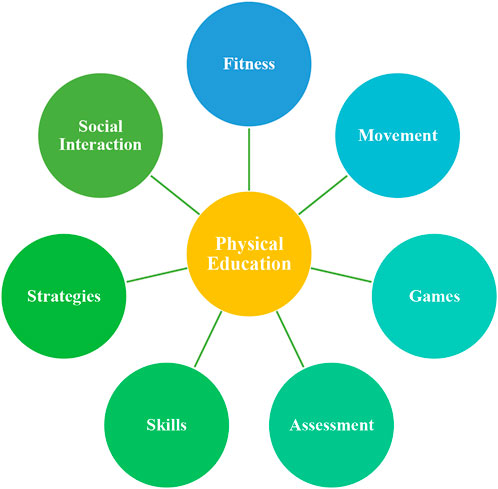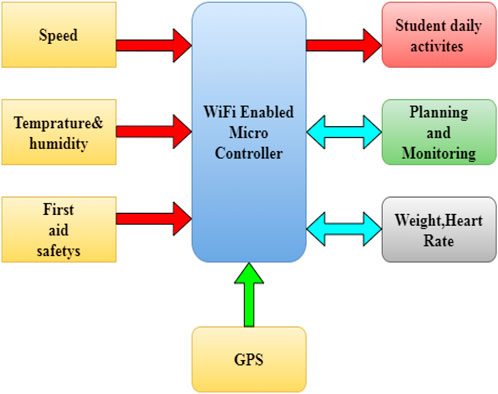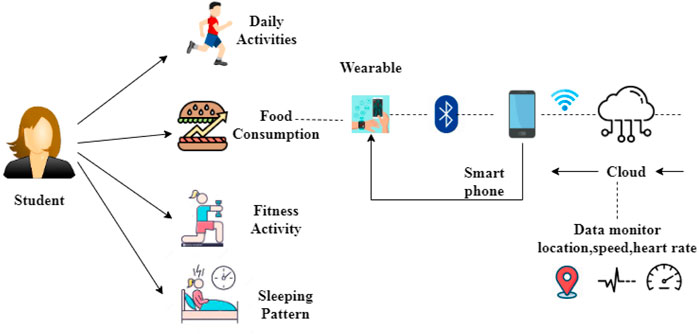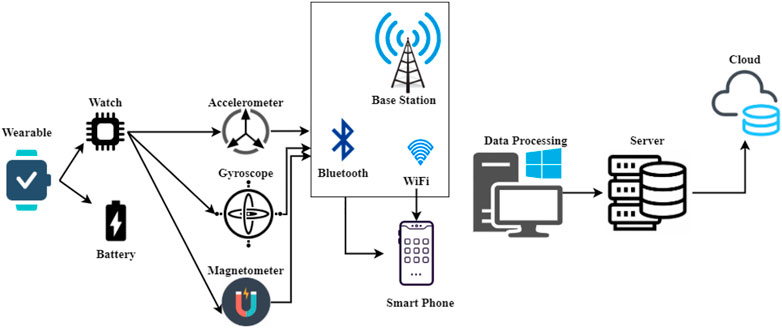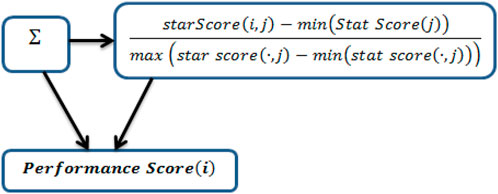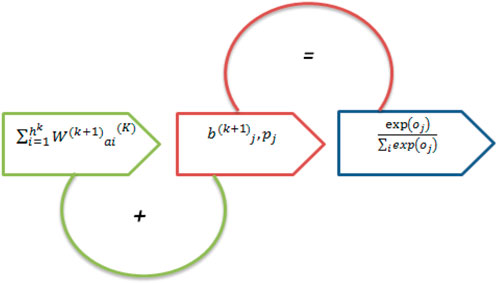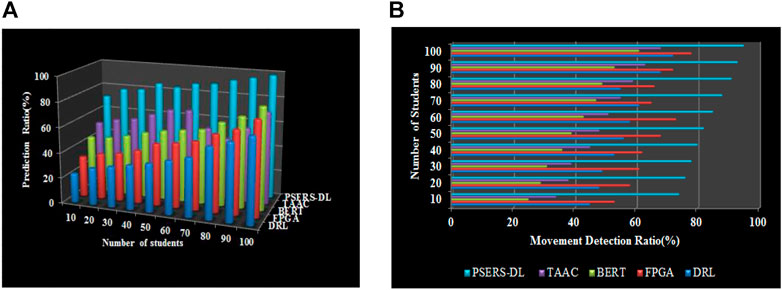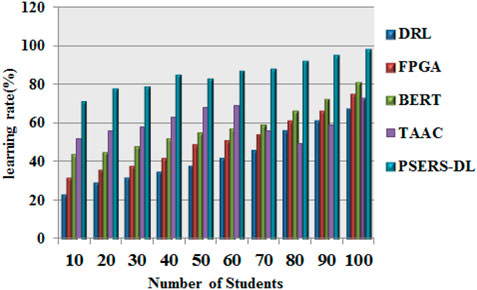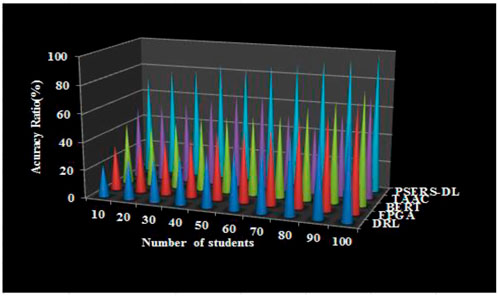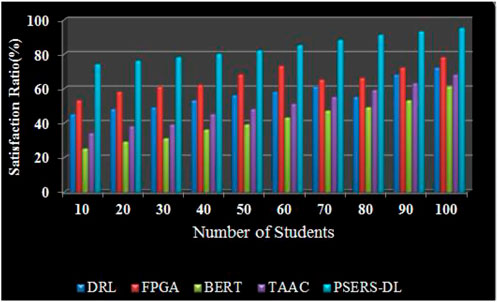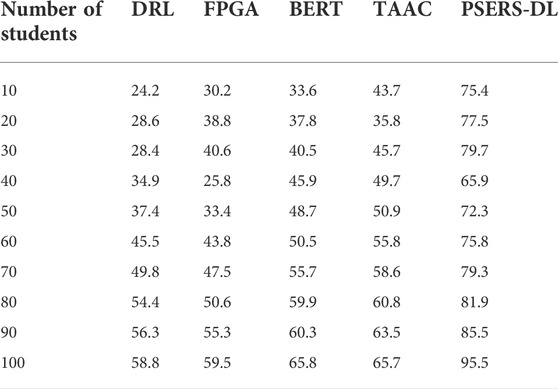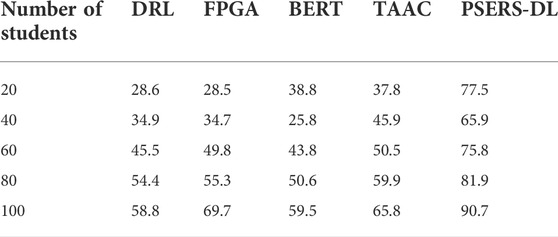Physical education and emergency response system using deep learning: A step toward sustainable development of physical education environment
- Department of Physical Education, Zhongnan University of Economics and Law, Wuhan, China
The physical education (PE) system’s key goal is to educate individuals and the large community of participating students to achieve self-fulfillment. Deep learning uses integrated expertise to help students master challenging conditions in unfamiliar contexts. It is normal to get injuries while training or playing, and as an emergency response to mitigating students’ future risks by the availability of first aid, safety steps are promptly taken. Therefore, this article suggests a “physical education and emergency response system using deep learning” (PSERS-DL) to handle such situations effectively. In real-time, the PE environment can be tracked using a global positioning system-enabled surveillance system to immediately provide the wounded student with protective measures. The acquired visuals are immediately analyzed using a deep learning model, convolutional neural network (CNN). The 27 layers proposed in the CNN model have been evaluated compared with other deep learning models. The simulation results showed that the proposed PSERS-DL can assure the emergency response with the highest accuracy of 97.61%. The experimental results showed that the proposed PSERS-DL model enhances an accuracy ratio of 95.6%, a performance ratio of 97.6%, movement detection analysis ratio of 96.3%, a learning rate of 95.2%, an efficiency ratio of 98.1%, a security ratio of 93.5%, a delay time ratio of 33.2%, and a behavior analysis ratio of 90.7% when compared to other existing approaches.
1 Introduction
Physical education is intended to improve students’ physical experiences, competencies, safety, and capacity to use them in a broad range of wellness behaviors. Physical education is commonly understood as an organization of events in athletics, sports, or physical training (Lakhani & Sundaram, 2017). During such events, it is found that most students are either left to play the matches in their way or taken to the field where they practice various sports without the teacher’s instruction or supervision (Manogara et al., 2018; Raizada et al., 2021). All these experiences together provide an essential comprehension of the idea of physical education (Abdel-Basset, et al., 2019). Physical education is focused on physical fitness and the ability to conduct and relish daily physical exercise (Wang et al., 2016; Li et al., 2020). Children gain the skills required for participating in a broad array of sports, including football, basketball, and swimming. Daily physical training course prepares the children to be involved, fit, and stable in their own physical and mental growth (Vinayakumar et al., 2019; Thakur et al., 2021; Sohail et al., 2022a; Sohail et al., 2022b). A successful physical education curriculum should include teaching students, psychiatrists, and teachers; proper education; and student assessment. Learning to develop body fitness starts from basic physical exercises to a training course in grooming, gymnastics, and athletic game performance and management (Janarthanan et al., 2020; Awan et al., 2021).
Physical training assists students in developing physical skills and confidence. For instance, primary and secondary schools’ curricula involve activities that allow children to gain or develop their abilities, such as running, catching, throwing, or karate (Janarthanan et al., 2020). High school education should concentrate on tennis or aerobic dance, focusing on competitive sports (Kumar et al., 2018). Physical education creates strength and encourages the ability to be involved in physical activity for a lifetime (Xu et al., 2020). Physical education programs teach the health benefits and hazards of a dysfunctional and unhealthy diet and the importance of daily exercise and balanced food choices (Zhao et al., 2019; Kumaran et al., 2021; Zhao et al., 2022a; Zhao et al., 2022b; Zhenyu and Sohali, 2022). Students of all ages may be required to focus on a few minor dietary and exercise changes over six weeks (Kumar et al., 2019). Physical training can enhance the behavior, cognitive, and social capacity of students (Huifeng et al., 2020; Mustafa et al., 2022b). Team sports help students value others, contribute to a team objective, and socialize as positive team members (Anbarasan et al., 2020; Raizada et al., 2021). Physical training includes holistic training for the complete growth of the child’s personality and body, mind, and spirit excellence through daily engagement (Sohail et al., 2015; Zhou et al., 2016; Mustafa et al., 2022a). The medium of physical fitness, physical exercises, allows us to achieve and sustain a fitness shape. It helps achieve high physical and mental performance (Kang and Choo, 2016; Rathore et al., 2016). Alertness and abilities such as perseverance, team spirit, teamwork, and rule-making are developing. Therefore, it improves the students’ personal and social skills and positively impacts their physical, social, emotional, and mental growth (Okumura et al., 2003; Upadhyay et al., 2008). Thus, physical training can be described as a field that does not focus on physical fitness but aims to develop a range of skills and behavior. Physical training teaches cooperation, respect, integrity, trust, the gain of grace, and the loss of hope (Redd et al., 1992).
To achieve and maintain a healthy lifestyle with abilities, skills, values, and enthusiasm, higher education institutions must concentrate on designing physical education courses (Sohail et al., 2014b; Popp et al., 2018; Sohail et al., 2022c; Lu and Sohali, 2022). To encourage exercise, motor skills, the comprehension of games and sports rules, principles, and strategies, the trainer needs to monitor the student (Kanchanasut et al., 2007). Students are either trained in a team or in a range of competitive activities as individuals. Learn motor skills such as strength, speed, stamina, coordination, flexibility, agility, and balance since these are crucial aspects of success in various games and sports (Trudeau and Shephard, 2008; Sohail et al., 2022d). Building sustainable strategies and methods involved in physical activity (Sohail and Delin, 2013a; Sohail et al., 2013b; Sohail et al., 2014a; Yen et al., 2017; Yat et al., 2018; Liu et al., 2020; Yen et al., 2021). The main contributions of this article are as follows: 1) designing a PSERS-DL has been proposed to reduce physical education students’ risk factors for learning and handle such situations effectively; 2) analyzing the PE environment by a global surveillance system and predicting the injured student to take safeguards instantly; and 3) the experimental results have been analyzed, and the proposed system PSERS-DL has been improving safety measures for students and enhancing learning outcomes in physical education. The rest of the article is organized as follows: Section 1 and Section 2 discuss the physical education and emergency response system and existing methods. In Section 3, the PSERS-DL model is suggested. In Section 4, the experimental results are executed. Finally, Section 5 concludes the research article.
2 Literature review
Liu et al. (2020) focused on creating a computational regulation of behaviors using the Internet of Robotic Things (IoRT). Two major methodologies are used in this deep learning solution for robotic behavior management, deep reinforcement learning (DRL). Robot behavior control models the robot with the features required to react to its immediate environment via sensory-motor connections. To recognize robots’ actions, DRL combines the principle of deep learning architecture with neural networks and reinforcement algorithms. Min (2021) discussed the field-programmable gate array (FPGA) for welfare organization management. The value of using a variety of methods to speed up main characteristics. Study methods are the new changes in deep learning networks based on FPGA in this study. Therefore, in the analysis of the direct and effective hardware acceleration of potential development researchers, this examination is intended to be useful. Lee and Lee (2021) suggested using artificial intelligence (AI) for physical education. Using AI in physical education (PE) and sports applications can enhance its possible use and improve the nature, visualization, and repetitiveness of PE. This study examines the concepts and use of PE based on AI-related research fields’ philosophy and offers a concentrated, in-depth review of the PE technologies. To apply AI-based custom PE lessons, information provision, learner assessment, and learner therapy methods, AI facilitates educators’ decision-making by reporting to learners on their status and providing different solutions to learners’ problems in real-time. It supports educators efficiently in assessing and managing to learn.
Sung et al. (2020) introduced the Bidirectional Encoder Representations from Transformers (BERT) framework for categorizing ended responses into suitable categories with improved efficiency than conventional machine learning systems. In the processing of primary analysis, the satisfaction of deep learning in assigning many codes is innovative. The research has a simple method for analyzing qualitative data that does not fulfill mutual university. Telford et al. (2021) deliberated that the centerpiece of school physical education (PE) can be called physical education with ineffectual instruction. The lack of PE throughout the system of public primary schools has raised concerns. This analysis’s objective was to assess the implementation, acceptability, and impact of PE teachers’ provision in an integrated PEP approach to improve PE and PL opportunities for teachers in the classroom of a group of suburban elementary schools. Cao et al. (2020) initialized the topology-aware access control (TAAC) for the cyber-physical space access control system. It can potentially describe the control of cyber access, physical access control, and interaction access control, and for the policy compliance process, a risk evaluation approach is proposed. They suggested a role activation algorithm that would allow only legitimate and honest users to access items.
There are several challenges to existing methods to implement physical education and emergency response system. To come across the issues in this study, the PSERS-DL model has been suggested. The following section discusses the proposed model briefly. This article discusses the physical education and emergency response system using deep learning for improving student learning and enhancing physical training outcomes. Physical education supports students in achieving movement, safety knowledge, developing their physical abilities, and using various active events. Physical education (PE) allows students to maintain fitness and acquire positive social skills, and it builds the students’ capacity and confidence to engage in a wide variety of physical activities. The study aims to analyze the degree of physical activity in community educational institutions. Data have been analyzed to determine whether physical education could enable young people to meet their health goals through prescribed physical activities accurately. The physical education components are shown in Figure 1.
Figure 1 shows the physical education components. The four major physical education objectives are nutrition, physical activity, athletic development, and social skills. Physical education goals include the understanding of the student body’s growth and development of personality. The purpose of this article is to evaluate skill development progress across the integrated process. Social contact is cited as a significant factor in the importance of adolescence movement experience. Regular physical activity for students offers direct health benefits, effects on physical appearance and muscle growth, and a reduction in individuals’ presence at high-risk failure. However, studies show that this condition is impractical and is rarely met in regular PE lessons. This study set a goal to determine students’ physical activity during secondary school PE. The data have been considered for the recommended levels of physical activity to determine and help students become healthy.
3 Methodology
3.1 Emergency response system
The emergency response system design provides an understanding of essential emergency response parameters outlined in Figure 2. Monitoring athletes and all students in physical education play a significant part. Sensors can be used to produce and install an emergency response system properly, and a few sensors are interfaced to establish internet connectivity through a WiFi-enabled microcontroller. The sensors used in the configuration are the heartbeat sensor for ambient temperature and humidity object stabilization accelerometer and GPS module for situating the emergency reaction site. The number of moves and emergencies can be counted as droppings that generate the signal in the object’s movement, such as planning, living, behavior, and tracking.
The standard magnitude vector estimated values in the region of the signal smart emergency response system are formalized in Eq. 1:
As shown in Eqs. 1 and 2, signal magnitude area
3.2 Wearable sensor-based fitness process
Monitoring and evaluation (M&E) are two separate harmonizing, mutually enhancing methods based on wearable sensors. Generally, M&E is intended to track a strategy’s effectiveness on the overall goals, priorities, objectives, and program operation progress. M&E often evaluates an activity’s result significance and its performance, learning rate, efficiency, and sustainability on program effectiveness.
Figure 3 shows the fitness tracking process. Wearable systems include accelerometers, gyroscopes, sole sensors, and body-mounted barometric pressure sensors. To track their physiological and biochemical properties, different body sensors have been developed. The sensor is a microphone and is discreetly worn on the neck. Sound characteristics are extracted in real-time, and the camera records a video sequence for further study if a chewing action is classified. The sensors can sense variations in temperature, illumination, movement, vibration, or pressure of students. The combined use of wearable sensors and environmental sensors may provide useful information about the individual living under monitoring. Actigraphy instruments rely on an accelerometer to measure movement patterns (motion) and estimate sleep and wake conditions simply by assuming that motion means waking and sleeping. Tracking the eye movement helps the detection of gazing activities like reading and concentrating movements. The sensor network collecting and disseminating sensed data is a necessary component of wearable computing. The lightweight application programming interface (API) is used for direct sensor connectivity with a cloud while the data collected, users, and sensors are served in a highly scalable way. Fitness data monitors are standard instruments used to assess physical involvement in class times and strengthen fitness principles related to well-being, such as aerobic ability and enhancing quantitative physical activity metrics inside and outside schools (Mustafa et al., 2022c). The understanding of wearable technology started with a wearable device, that is, a completely controllable device that can run without thinking or effort. It is a part of the user that this form can be seen in today’s wearables, as they are considered "smart” since they are run with less human input into the controls because the consumer is free to take action from the fitness trackers.
3.3 Activity recognition wearable sensors
Student activity recognition, which has expertise in students’ activities from raw sensor inputs, plays an important role in everyday life. It aims to understand students’ conduct that enables computing systems to support users proactively based on their needs. Suppose a student carries out certain types of activities that belong to specified
As explored in Eq. 3, student activity has been calculated.
As inferred, in Eq. (4), sensor reading has been computed, where
To predict the sequence of activities using sensors, a model
As calculated in Eq. 5, sensor-based activity predicts the sequence. However, the actual sequence of operation (ground truth) is as shown in Eq. 6:
As deliberated in Eq. 6, the ground truth of sensor sequence operation has been obtained. In Eq. 6,
The human activity recognition objective is to learn model
The wearable device can be seen as an existing device in which a consumer’s priority can see exercise as a routine instead of an activity. Figure 3 shows what a new wearable customer fitness process looks like concerning the individual.
The inertial measurement unit (IMU), GPS (global positioning system), magnetometer, gyroscope, and accelerometer sensors are often present in sports wearables configured. The inertial measurement unit can be used in various physical monitoring applications. In this study, there are differences in which sensors are compatible and which sensor technology can be adapted for sporting applications.
Figure 4 illustrates the wearable sensor framework. An IMU chip with a wearable sensor can monitor data and communicate via wireless technology. The preference for servers or phones with WiFi or Bluetooth depends on the customer, and the designer gets input. Sensors that regularly send and receive data will help to consume power. The advantage of integrated smartphone-based wearable technology is that it can optimize storage capacity (Mustafa et al., 2022d). Wearables are based on constant teachings and all data that wearable monitors can use. For PE training and learning, utilizing server or cloud services to store student data tracks live encryption and storage priority (Zhongjun et al., 2022).
Physical education has a concrete connection to physical activity for students. Activity data quantitatively represent a student-action state and are qualitatively evaluated by reports. It is possible to suppose that the phrases that relate to a student seem to have a polarity if students played well in physical education. In this context, two sentence-level annotation techniques have been proposed, and four physical annotation methods are performed throughout a season. In contrast, daily annotation is the second method focused on a student’s success in physical education. Based on the average statistics for the whole season, the first approach evaluates the security and success rating of the
The basic architecture contains the sum of the input layer’s weighted input values for each hidden unit in the first hidden layer. This weighted sum is transformed using the
As expressed in Eq. 9, the output of the hidden node has been explored. Eq. 9 shows the
Figure 6 signifies the softmax function. A deep neural network (DNN) is qualified for identification to increase the prediction error over the data, which is equivalent to reducing the cross-entropy optimization problem in Eq. 11:
As found in Eq. 11, cross-entropy optimization has been explored, where
4 Result and discussion
The physical education (PE) system’s key goal is to educate individuals and the large community of participating students to achieve self-fulfillment. Deep learning uses integrated expertise to help students master challenging conditions in unfamiliar contexts. The proposed PSERS-DL models for preventing student injuries and monitoring physical activity. The experimental results have been performed, and the suggested PSERS-DL model is based on the performance metrics such as accuracy ratio, prediction ratio, efficiency ratio, security rate, and delay time ratio.
4.1 Performance ratio and error rate (%)
Fitness can involve student skills, attitudes, and academic performance, which are important elements for improving school performance. PE includes improved interest, concentration, and student performance. Physical training affects cognitive skills such as focus and enhances student habits which are essential components of increased student performance. Physical education develops students’ concentration expression and improves memory, better heart health, lowers the risk of depression, bone health, and weight and improves grades. It makes us work successfully, appreciates recreational activities, and cope with emergencies. It can help us feel very healthy while learning to improve our physical health. Figure 7A shows the performance ratio.
Figure 7B shows error rate; physical education system strengthens student education and improves physical activities to care for the student’s environment. These include recognizing the importance of using programs for the improvement of physical activity in the learning environment. Recognition of current opportunity inequalities and the need for equality of physical and physical activities.
4.2 Prediction ratio and movement detection ratio (%)
The deep learning (DL) models were used to calculate the accelerometer data’s fitness values and determine the positioning location to predict physical activity (PA) data. These models showed a preference for the main wrist or shoulder, as the action is more stable in these positions. DL models using these positions were useful in predicting student PA accurately. The routine framework has been organized around physical activity, and high prediction is provided by physical education (PE). In this respect, PE’s position on the school curriculum is generally justified by its commitment to health and fitness. However, the assumption seems to have some merit because PE is often highlighted as a major contributor to young people’s everyday physical activity. DL is considered patterns in an acceleration signal instead of using the acceleration magnitude for the prediction. Research shows, however, that this criterion is very ambitious and that it is rarely encountered during PE lessons every day. Figure 8A shows the PSERS-DL curriculum prediction ratio.
Figure 8B shows the PSERS-DL curriculum movement detection ratio that students can learn a range of skills, activities of the movement, and qualities. It is important to study whether exercises can be used as a lesson to practice different movements. This article aims to research students’ different movement detection usage during the PSRES-DL period using new educational tools and emphasize numerous movement qualities.
4.3 Learning rate (%)
Students can build skills and use this knowledge to increase their skills in various circumstances. Students reach a health-enhancing fitness level and show physical activity and recognize that physical activity offers opportunities for pleasure, challenge, and self-expression. Students will show responsibility for their acts during their participation in the campaign and display responsible social behavior. Prove progress in fitness areas assessed by the department’s deep learning system using the basic abilities, experience, manners, and vocabulary used in practical and fighting tasks. Figure 9 shows the physical education and emergency response system’s learning rate using deep learning (PSERS-DL) to handle such situations effectively.
4.4 Accuracy ratio (%)
Physical training (PE) builds students’ skills and confidence in various physical activities integral and school life. The PE program’s accuracy allows all students to participate in a variety of physical activities and excel. The importance of sports accuracy will be known to those who have completed sports coaching courses. The students can choose and build user-friendly environments, exhibit sequence training, and incorporate learning styles and performance modifications based on good education values. Students demonstrate movement expertise, analyze physical training’s success, develop and learn written lesson schemes, analyze fitness learning for students, assess it, and include the description and implementation of conceptual physical training for highly qualified employment, movement, sport, and physical development. Figure 10 shows the accuracy ratio.
4.5 Satisfaction ratio
The research was conducted to recognize students’ satisfaction with physical education (PE). Students score the need for a high quality of good life; however, their school’s contribution to healthy living is unsatisfactory. The PE training supports multiple physical exercises and gathers knowledge, values, and functions related to other educational concerns. The students were best satisfied with peer interaction among the four aspects of PE learning impact, teacher training, and facility. The students’ satisfaction with PE ranged from average to satisfied. Figure 11 shows the student satisfaction ratio in PSERS-DL.
4.6 Security ratio (%)
Each student’s and teacher’s development is within their capacity and confidence. Ensure that traffic patterns are flowing around the equipment to prevent accidents. Guaranteeing the equipment is installed correctly, loaded, stretched, and used according to the system’s wishes and that the operating devices are systematically started and finished. Table 1 shows the student security ratio is high in PSERS-DL.
4.7 Behavior analysis ratio
A summary of behavioral analysis shows that student data history and experiments in physical education settings are given in this article. To evaluate the effects of behavioral interventions in teachers’ training settings based on the question. Table 2 provides descriptive data on the actions of students over several similar courses.
Considering the advantages reported by students in assessing training classes to analyze the relationship between student obligation assignment, motivation variables, and satisfaction with physical education classes, three different characteristics were offered: sports challenges, fitness activities, and aerobic activity. The movement’s detection examines students’ qualities on four levels: body, effort, space, and relations. Our findings show that exercises allow PE teachers and students to pay attention to various teaching qualities. In PE, the player engages in a complex sense of movement with physical exercise and other students.
The proposed PSERS-DL model enhances the accuracy ratio, performance ratio, movement detection analysis ratio, learning rate, efficiency ratio, security ratio, delay time ratio, and behavior analysis ratio when compared to deep reinforcement learning (DRL), field-programmable gate array (FPGA), Bidirectional Encoder Representations from Transformers (BERT) framework, and topology-aware access control (TAAC) methods.
5 Conclusion
This article discussed the emergency response system based on deep learning for student physical activity monitoring and improving student fitness. The provision of first aid protection steps is an emergency solution to reduce potential injury risks to students. Therefore, in this article, PSERS-DL has been proposed to sports emergency management and handle physical education’s critical situation. A global GPS allows surveillance systems to map the PE field in real-time so that the wounded student can automatically take safety action. Physical education programs worldwide are under strong pressure to prove that their practice prepares students for good active and long-term living. The experimental results show that the proposed PSERS-DL model enhances an accuracy ratio of 95.6%, a performance ratio of 97.6%, a movement detection analysis ratio of 96.3%, a learning rate of 95.2%, an efficiency ratio of 98.1%, a security ratio of 93.5%, a delay time ratio of 33.2%, and a behavior analysis ratio of 90.7% when compared to other existing approaches. This study can be used for physical education and emergency response system using deep learning and it can help to develop a better physical education environment.
Data availability statement
The original contributions presented in the study are included in the article/Supplementary Material; further inquiries can be directed to the corresponding author.
Author contributions
The author confirms being the sole contributor to this work and has approved it for publication.
Conflict of interest
The author declares that the research was conducted in the absence of any commercial or financial relationships that could be construed as a potential conflict of interest.
Publisher’s note
All claims expressed in this article are solely those of the authors and do not necessarily represent those of their affiliated organizations, or those of the publisher, the editors, and the reviewers. Any product that may be evaluated in this article, or claim that may be made by its manufacturer, is not guaranteed or endorsed by the publisher.
References
Abdel-Basset, M., Manogaran, G., Gamal, A., and Chang, V. (2019). A novel intelligent medical decision support model based on soft computing and IoT. IEEE Internet Things J. 7 (5), 4160–4170. doi:10.1109/jiot.2019.2931647
Anbarasan, M., Muthu, B., Sivaparthipan, C. B., Sundarasekar, R., Kadry, S., Krishnamoorthy, S., et al. (2020). Detection of flood disaster system based on IoT, big data and convolutional deep neural network. Comput. Commun. 150, 150–157. doi:10.1016/j.comcom.2019.11.022
Awan, F. H., Dunnan, L., Jamil, K., Mustafa, S., Atif, M., Gul, R. F., et al. (2021). Mediating role of green supply chain management between lean manufacturing practices and sustainable performance. Front. Psychol. 12, 810504. doi:10.3389/fpsyg.2021.810504
Cao, Y., Huang, Z., Yu, Y., Ke, C., and Wang, Z. (2020). A topology and risk-aware access control framework for cyber-physical space. Front. Comput. Sci. 14 (4), 144805. doi:10.1007/s11704-019-8454-0
Huifeng, W., Shankar, A., and Vivekananda, G. N. (2020). Modelling and simulation of sprinters’ health promotion strategy based on sports biomechanics. Connect. Sci. 33, 1028–1046. doi:10.1080/09540091.2020.1807467
Janarthanan, R., Doss, S., and Baskar, S. (2020). Optimized unsupervised deep learning assisted reconstructed coder in the on-nodule wearable sensor for human activity recognition. Measurement 164, 108050. doi:10.1016/j.measurement.2020.108050
Kanchanasut, K., Tunpan, A., Awal, M. A., Das, D. K., Wongsaardsakul, T., Tsuchimoto, Y., et al. (2007). Dumbonet: A multimedia communication system for collaborative emergency response operations in disaster-affected areas. Int. J. Emerg. Manag. 4 (4), 670. doi:10.1504/ijem.2007.015736
Kang, B., and Choo, H. (2016). A deep-learning-based emergency alert system. Ict Express 2 (2), 67–70. doi:10.1016/j.icte.2016.05.001
Kumar, A., Mukherjee, S., and Luhach, A. K. (2019). Deep learning with perspective modeling for early detection of malignancy in mammograms. J. Discrete Math. Sci. Cryptogr. 22 (4), 627–643. doi:10.1080/09720529.2019.1642624
Kumar, P. M., Manogaran, G., Sundarasekar, R., Chilamkurti, N., and Varatharajan, R. (2018). Ant colony optimization algorithm with Internet of Vehicles for intelligent traffic control system. Comput. Netw. 144, 154–162. doi:10.1016/j.comnet.2018.07.001
Kumaran, U., Rammohan, S. R., Nagarajan, S. M., and Prathik, A. (2021). Fusion of mel and gammatone frequency cepstral coefficients for speech emotion recognition using deep C-RNN. Int. J. Speech Technol. 24, 303–314. doi:10.1007/s10772-020-09792-x
Lakhani, P., and Sundaram, B. (2017). Deep learning at chest radiography: Automated classification of pulmonary tuberculosis by using convolutional neural networks. Radiology 284 (2), 574–582. doi:10.1148/radiol.2017162326
Lee, H. S., and Lee, J. (2021). Applying artificial intelligence in physical education and future perspectives. Sustainability 13 (1), 351. doi:10.3390/su13010351
Li, S., Zhang, B., Fei, P., Shakeel, P. M., and Samuel, R. D. J. (2020). Computational efficient wearable sensor network health monitoring system for sports athletics using IoT. Aggress. Violent Behav., 101541. doi:10.1016/j.avb.2020.101541
Liu, Y., Zhang, W., Pan, S., Li, Y., and Chen, Y. (2020). Analyzing the robotic behavior in a smart city with deep enforcement and imitation learning using IoRT. Comput. Commun. 150, 346–356. doi:10.1016/j.comcom.2019.11.031
Lu, F., and Sohail, M. T. (2022). Exploring the effects of natural capital depletion and natural disasters on happiness and human wellbeing: A study in China. Front. Psychol. 13, 870623. doi:10.3389/fpsyg.2022.870623
Manogaran, G., Varatharajan, R., Lopez, D., Kumar, P. M., Sundarasekar, R., Thota, C., et al. (2018). A new architecture of Internet of Things and big data ecosystem for secured smart healthcare monitoring and alerting system. Future Gener. Comput. Syst. 82, 375–387. doi:10.1016/j.future.2017.10.045
Min, Z. (2021). Public welfare organization management system based on FPGA and deep learning. Microprocess. Microsystems 80, 103333. doi:10.1016/j.micpro.2020.103333
Mustafa, S., Sohail, M. T., Alroobaea, R., Rubaiee, S., Anas, A., Othman, A. M., et al. (2022a). Éclaircissement to understand consumers’ decision-making psyche and gender effects, a fuzzy set qualitative comparative analysis. Front. Psychol. 13, 920594. doi:10.3389/fpsyg.2022.920594
Mustafa, S., Tengyue, H., Jamil, K., Qiao, Y., and Nawaz, M. (2022c). Role of eco-friendly products in the revival of developing countries' economies & achieving a sustainable green economy. Front. Environ. Sci. 10. doi:10.3389/fenvs.2022.955245
Mustafa, S., Tengyue, H., Qiao, Y., Sha, S. K., and Sun, R. (2022d). How a successful implementation and sustainable growth of e-commerce can be achieved in developing countries; a pathway towards green economy. Front. Environ. Sci. 10. doi:10.3389/fenvs.2022.940659
Mustafa, S., Wen, Z., and Naveed, M. M. (2022b). What motivates online community contributors to contribute consistently? A case study on stackoverflow netizens. Curr. Psychol. 41 (6), 1–14. doi:10.1007/s12144-022-03307-4
Okumura, T., Ninomiya, N., and Ohta, M. (2003). The chemical disaster response system in Japan. Prehosp. Disaster Med. 18 (3), 189–192. doi:10.1017/s1049023x00001047
Popp, J. K., Berry, D., and Judge, L. W. (2018). Physical education and athletic facility emergency readiness: The emergency action plan. Phys. Educ. 75 (4), 633–646. doi:10.18666/tpe-2018-v75-i4-8208
Raizada, S., Verma, Y., Mala, S., Shankar, A., and Thakur, S. (2021). “Organ risk prediction for Parkinson’s disease using deep learning techniques,” in 2021 11th International Conference on Cloud Computing, Data Science & Engineering (Confluence), 28-29 Jan. 2021 (IEEE), 978–983.
Rathore, M. M., Ahmad, A., Paul, A., Wan, J., and Zhang, D. (2016). Real-time medical emergency response system: Exploiting IoT and big data for public health. J. Med. Syst. 40 (12), 283. doi:10.1007/s10916-016-0647-6
Redd, J. L., Zura, R. D., Tanner, A. E., Walk, E. E., and Wu, M. M. (1992). Personal emergency response systems. J. Burn Care Rehabil. 13 (4), 453–459. doi:10.1097/00004630-199207000-00013
Sohail, M. T., and Delin, H. J. I. J. (2013a). Job satisfaction surrounded by academic staff: A case study of job satisfaction of academic staff of the gcul, Pakistan. Interdiscip. J. Contemp. Res. Bus. 4 (11), 126–137.
Sohail, M. T., Delin, H., Siddiq, A., Idrees, F., and Arshad, S. (2015). Evaluation of historic Indo-Pak relations, water resource issues and its impact on contemporary bilateral affairs. Asia Pac. J. Multidiscip. Res. 3 (8).
Sohail, M. T., Delin, H., and Siddiq, A. (2014a). Indus basin waters a main resource of water in Pakistan: An analytical approach. Curr. World Environ. 9 (3), 670–685. doi:10.12944/cwe.9.3.16
Sohail, M. T., Delin, H., Talib, M. A., Xiaoqing, X., and Akhtar, M. M. (2014b). An analysis of environmental law in Pakistan-policy and conditions of implementation. Res. J. Appl. Sci. Eng. Technol. 8 (5), 644–653. doi:10.19026/rjaset.8.1017
Sohail, M. T., Ehsan, M., Riaz, S., Elkaeed, E. B., Awwad, N. S., Ibrahium, H. A., et al. (2022a). Investigating the drinking water quality and associated health risks in metropolis area of Pakistan. Front. Mat. 9, 864254. doi:10.3389/fmats.2022.864254
Sohail, M. T., Elkaeed, E. B., Irfan, M., Acevedo-Duque, Á., and Mustafa, S. (2022b). Determining farmers’ awareness about climate change mitigation and wastewater irrigation: A pathway towards green and sustainable development. Front. Environ. Sci. 10, 193. doi:10.3389/fenvs.2022.90019
Sohail, M. T., Huang, D., Bailey, E., Akhtar, M. M., and Talib, M. A. (2013b). Regulatory framework of mineral resources sector in Pakistan and investment proposal to Chinese companies in Pakistan. Am. J. Industrial Bus. Manag. 3 (05), 514–524. doi:10.4236/ajibm.2013.35059
Sohail, M. T., Majeed, M. T., Shaikh, P. A., and Andlib, Z. (2022c). Environmental costs of political instability in Pakistan: Policy options for clean energy consumption and environment. Environ. Sci. Pollut. Res. 29 (17), 25184–25193. doi:10.1007/s11356-021-17646-5
Sohail, M. T., Mustafa, S., Ma, M., and Riaz, S. (2022d). Agricultural communities’ risk assessment and the effects of climate change: A pathway toward green productivity and sustainable development. Front. Environ. Sci. 10. doi:10.3389/fenvs.2022.948016
Sung, S. H., Li, C., Chen, G., Huang, X., Xie, C., Massicotte, J., et al. (2020). How does augmented observation facilitate multimodal representational thinking? Applying deep learning to decode complex student construct. J. Sci. Educ. Technol. 30, 210–226. doi:10.1007/s10956-020-09856-2
Telford, R. M., Olive, L. S., Keegan, R. J., Keegan, S., and Telford, R. D. (2021). Teacher and school outcomes of the physical education and physical literacy (PEPL) approach: A pragmatic cluster randomised controlled trial of a multicomponent intervention to improve physical literacy in primary schools. Phys. Educ. Sport Pedagogy 26 (1), 79–96. doi:10.1080/17408989.2020.1799965
Thakur, S., Chakraborty, A., De, R., Kumar, N., and Sarkar, R. (2021). Intrusion detection in cyber-physical systems using a generic and domain specific deep autoencoder model. Comput. Electr. Eng. 91, 107044. doi:10.1016/j.compeleceng.2021.107044
Trudeau, F., and Shephard, R. J. (2008). Physical education, school physical activity, school sports and academic performance. Int. J. Behav. Nutr. Phys. Act. 5 (1), 10. doi:10.1186/1479-5868-5-10
Upadhyay, R., Pringle, G., Beckett, G., Potter, S., Han, L., Welch, S., et al. (2008). An architecture for an integrated fire emergency response system for the built environment. Fire Saf. Sci. 9, 427–438. doi:10.3801/iafss.fss.9-427
Vinayakumar, R., Alazab, M., Jolfaei, A., Soman, K. P., and Poornachandran, P. (2019). “Ransomware triage using deep learning: Twitter as a case study,” in 2019 Cybersecurity and Cyberforensics Conference (CCC), Melbourne, Australia, May 8 2019 to May 9 2019, 67–73.
Wang, S., Lei, T., Zhang, L., Hsu, C. H., and Yang, F. (2016). Offloading mobile data traffic for QoS-aware service provision in vehicular cyber-physical systems. Future Gener. Comput. Syst. 61, 118–127. doi:10.1016/j.future.2015.10.004
Xu, X., Chen, Y., Zhang, J., Chen, Y., Anandhan, P., Manickam, A., et al. (2020). A novel approach for scene classification from remote sensing images using deep learning methods. Eur. J. Remote Sens. 54, 383–395. doi:10.1080/22797254.2020.1790995
Yat, Y. E. N., Yumin, S. H. I., Bunly Soeung, R. S., Suy, R., and Sohail, M. T. (2018). Victimization of the substance abuse and sexual behaviors among junior high school students in Cambodia. Iran. J. Public Health 47 (3), 357–366.
Yen, Y., Wang, Z., Shi, Y., Xu, F., Soeung, B., Sohail, M. T., et al. (2017). The predictors of the behavioral intention to the use of urban green spaces: The perspectives of young residents in Phnom Penh, Cambodia. Habitat Int. 64, 98–108. doi:10.1016/j.habitatint.2017.04.009
Yen, Y., Zhao, P., and Sohail, M. T. (2021). The morphology and circuity of walkable, bikeable, and drivable street networks in Phnom Penh, Cambodia. Environ. Plan. B Urban Anal. City Sci. 48 (1), 169–185. doi:10.1177/2399808319857726
Zhao, P., Yen, Y., Bailey, E., and Sohail, M. T. (2019). Analysis of urban drivable and walkable street networks of the ASEAN Smart Cities Network. ISPRS Int. J. Geoinf. 8 (10), 459. doi:10.3390/ijgi8100459
Zhao, W., Chang, M., Yu, L., and Sohail, M. T. (2022a). Health and human wellbeing in China: Do environmental issues and social change matter? Front. Psychol. 13, 860321. doi:10.3389/fpsyg.2022.860321
Zhao, W., Huangfu, J., Yu, L., Li, G., Chang, Z., Sohail, M. T., et al. (2022b). Analysis on price game and supervision of natural gas pipeline tariff under the background of pipeline network separation in China. Pol. J. Environ. Stud. 31 (3), 2961–2972. doi:10.15244/pjoes/145603
Zhenyu, W., and Sohail, M. T. (2022). Short-and long-run influence of education on subjective well-being: The role of ICT in China. Front. Psychol. 3027, 454. 10.3389/fpsyg.2022.92756.
Zhongjun, T., Shah, S. K., Ahmad, M., and Mustafa, S. (2022). Modeling consumer’s switching intentions regarding 5g technology in China. Int. J. Innov. Technol. Manag. 19, 2250011. Accessed 23/05/2022. doi:10.1142/S0219877022500110
Keywords: deep learning, emergency response system, physical education, students, sustainable development
Citation: Guangde Z (2022) Physical education and emergency response system using deep learning: A step toward sustainable development of physical education environment. Front. Environ. Sci. 10:974291. doi: 10.3389/fenvs.2022.974291
Received: 21 June 2022; Accepted: 08 July 2022;
Published: 19 August 2022.
Edited by:
Muhammad Tayyab Sohail, Xiangtan University, ChinaReviewed by:
Sana Ullah, Quaid-i-Azam University, PakistanSehrish Rana, Government Islamia graduate college for women, Faisalabad, Pakistan
Copyright © 2022 Guangde. This is an open-access article distributed under the terms of the Creative Commons Attribution License (CC BY). The use, distribution or reproduction in other forums is permitted, provided the original author(s) and the copyright owner(s) are credited and that the original publication in this journal is cited, in accordance with accepted academic practice. No use, distribution or reproduction is permitted which does not comply with these terms.
*Correspondence: Zhao Guangde, z0004741@zuel.edu.cn
 Zhao Guangde
Zhao Guangde